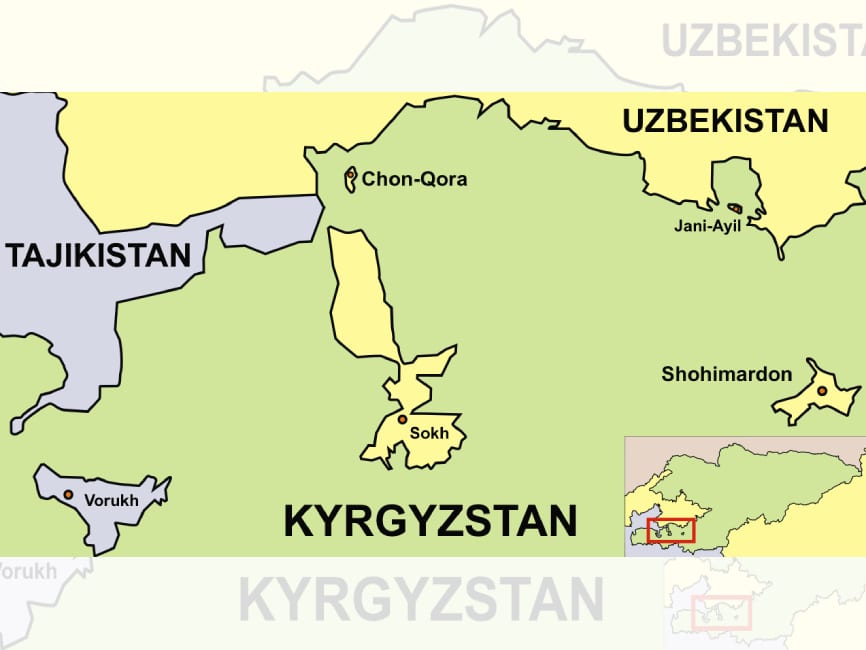
Verzija teksta na srpskom jeziku autora Zvezdane Grgić dostupna je na sledećem linku: Tekst na srpskom jeziku
Kyrgyzstan (officially the Kyrgyz Republic) and the Republic of Tajikistan, former members of the Soviet Union, were drawn immediately after its disintegration in 1991 into numerous mutual disputes and border conflicts. Tensions between the two neighbours have persisted to this day, and the events of the past few years have only further built up tension in Central Asia. Disagreement about state borders, disputed territories, the desire to acquire and provide more resources for their citizens, poor living standards and social and political instability have pushed the situation towards additional escalation instead of abatement, thus stirring fear of direct armed conflict.
Namely, the recent border conflict between the two countries seems to have been just a continuation of the discord that started in the disputed Kyrgyz province of Batken on April 28, 2021. The issue arose when the Tajik government decided to install surveillance cameras aimed at monitoring water pumps and tanks near Vorukh, one of the Tajik exclaves in Kyrgyzstan. In the beginning, a physical confrontation occurred between the local population and the workers setting up the equipment, but the conflict soon took on overwhelming proportions with the involvement of border troops from both sides. Since then, clashes have spread along the disputed border, forcing some 58,000 people away from their homes.
However, a truce was concluded between the two sides only three days later, and the UN Secretary-General, the OSCE and the EU, as well as Russia, Uzbekistan, Kazakhstan, Iran, Afghanistan, Pakistan, and the Organisation of Turkic States all played a crucial role in de-escalating the situation. The Chairmen of the State Committees for National Security of Tajikistan and Kyrgyzstan, Saimumin Yatimov and Kamchybek Tashiev, respectively, then announced the final ceasefire, which for many was a key move towards the future defusing of tensions in the region. However, despite their efforts, the truce did not last long, as five minor border conflicts between Kyrgyzstan and Tajikistan have been recorded since the beginning of 2022.

The first one occurred on January 27 and was presumably caused by a blockage of the road connecting the provincial centre of Batken and the Kyrgyz village of Isfana (now Razzaqov) by citizens of Tajikistan. The discord resulted in dozens of injured people on both sides and more than 24,200 Kyrgyz nationals evacuated from the mentioned area. In the second conflict, which took place on March 10 in the disputed area of the Teskey village, also a part of the Batken province, border troops of the State Committee for National Security of Tajikistan crossed the Kyrgyzstan border, which resulted in Kyrgyz border guards opening fire. This time too, the situation settled rapidly, and after telephone conversations between the commanders of the Tajikistan and Kyrgyzstan Border Troops, Rajabali Rahmonali and Ularbeek Sharsheev, it was decided that troops shall withdraw from the armed conflict field and that representatives of these services shall arrive in the disputed area. The conversation, however, did not result in a permanent solution, seeing that both countries further increased the number of border service unit members stationed in this area after the exchange of fire. All this only incited mounting tensions between the conflicting parties, which is why two new incidents already occurred at the beginning of June.
The tightening of relations between the two countries in the previous period resulted in increased tension over the disputed territories, which grew exponentially to supersede all previous proportions. The border conflicts thus became increasingly intense and violent, evidenced not only by the use of firearms but also mortars, the utilisation of which led to even more casualties. According to various sources, in the past few years, more than 100 people have died in clashes on the disputed border between Kyrgyzstan and Tajikistan, and a similar number of persons have been injured. Among them, the local civilian population comprises the majority of victims, which additionally points towards the alarming nature of the situation and the need to urgently find a peaceful solution to the current dispute. If the resolution is not agreed upon, a wide-scale open conflict between the two countries will eventually become inevitable.
However, it seems that it is not possible to reach a more permanent solution and peace in the near future. This claim is supported by the recent incidents that began on September 14, 2022, in which Kyrgyz border guards accused Tajik troops of occupying positions in the separation zone. An exchange of fire ensued, and five civilians were the first casualties. Over the next two days, the conflict escalated to the point where tanks and armoured personnel carriers were utilised, and Kyrgyzstan’s Batken airport was shelled, as a result of which state of emergency was declared in the area. This conflict was followed by mutual accusations between the two countries about the use of weapon systems, such as BM-21 Grad multiple rocket launchers and Bayraktar TB2 combat aerial vehicles for deliberate destruction and attacks on populated areas and civilian infrastructure.
Such a situation resulted in a vast number of deceased and wounded civilians from various villages in the disputed area, and according to Kyrgyz authorities, more than 300 civilian buildings, including markets and schools, were allegedly burned down and looted in the village of Ak-Sai, while almost 140,000 people were evacuated. On the other hand, Tajik officials asserted that 15 civilians were killed in an attack by a Kyrgyz Bayraktar TB2 drone on one of the mosques in the abovementioned area. Dushanbe authorities also claimed that many houses were scorched and dozens of seriously injured people were being treated in district hospitals in the border town of Sughd.
As in some previous cases, the two sides signed a ceasefire after facing pressure from international stakeholders this time as well. It happened at the Shanghai Cooperation Organization (SCO) summit on September 16 in Samarkand, Uzbekistan. However, despite renewed guarantees, clashes between the conflicting parties continued until September 19, when Kyrgyzstan declared a national day of mourning.
It is assumed that one of the reasons for the truce could, among other things, be the address by the President of the Russian Federation, Vladimir Putin, who called upon the leaders of the conflicting countries to de-escalate tensions and resolve disagreements "solely in a peaceful, diplomatic manner and through politics, as soon as possible". Although no skirmishes have taken place since then, the two countries have continued to accuse each other of escalating violence, recurrent provocations and disrespecting the armistice, simultaneously warning that they are ready to react at any moment. Apart from both sides allegedly hiding weaponry and military units in the disputed zone, the positions of the Tajik people living on the territory of Kyrgyzstan and the Kyrgyz people living on the territory of Tajikistan are increasingly being raised as an issue.
What remains unknown is whether the latest Tajik attack was planned to occur during the SCO summit’s opening, especially having in mind the renewed conflict between Azerbaijan and Armenia. More specifically, it can be questioned whether external actors and forces affected the re-escalation of the discord and Tajikistan's actions. Seeing that these Central Asian countries are low-income and underdeveloped, they are not only exposed to the influence of great powers, but they seemingly always strive to improve relations with as many of them as possible so as to ensure their development and progress. As post-Soviet states, they still belong to Russia's extremely strong sphere of interest, which is confirmed by the fact that there are Russian military bases in both countries and that both states are full members of the Collective Security Treaty Organization (CSTO).

An agreement on the construction of a railway line between China, Kyrgyzstan and Uzbekistan could serve as a confirmation of the stated thesis that the latest armed conflict was planned to take place precisely during the SCO summit in Samarkand in order to fulfil the interests of external actors. Namely, the officials of the three Asian countries signed a long-awaited agreement at the last summit with the aim of establishing a shorter route to Europe, bypassing the sanctions-hit Russia. As Kyrgyz officials believe, such a move initiated new conflicts on the border, which can also be interpreted as Moscow's open displeasure. In conjunction with their understanding of the relations between Tajikistan and the Russian Federation, there are claims that the President of Tajikistan, Emomali Rahmon, gives approval for attacks and violations of the Kyrgyz border with the support and knowledge of the Russian Head of State. On the other hand, one can question whether recent events favour other forces. What could support this assertion is the fact that Kyrgyzstan and Tajikistan are not the only post-Soviet states currently facing a crisis or conflict situation, as border conflicts between Armenia and Azerbaijan and internal issues in Kazakhstan are simultaneously ongoing.
In addition to everything mentioned, both countries are also facing internal problems. Speaking about Tajikistan, speculations say that the long-time President, Rahmon, is planning to hand over the position to his son Rustam Emomali, the incumbent Chairman of the country's National Assembly. Such a succession process typically requires demonstrations of power and regime stability, and the simplest way to do that is to initiate a short conflict with a positive outcome. Rahmon would likely also aim to divert the national and global audience’s attention from the current civil protests against police repression and control of the internet. As for Kyrgyzstan, in addition to insufficient military power and a fragile political regime, it is no secret that President Sadyr Japarov does not enjoy much respect in Moscow. Due to the neutral position Bishkek officials took regarding the Russian aggression against Ukraine, many feared this would displease Moscow and perhaps lead it to side with Dushanbe.
Nevertheless, while all global attention has been focused on Ukraine, the current status quo characterising frozen conflicts in Central Asia has been disrupted, with worrying consequences for the stability and security of this region. The escalation of the conflict between the two former Soviet republics has thus called into question many of the region’s international organisations established with a view to improving border security and preventing conflict, two of them being the Commonwealth of Independent States and the CSTO. Everything these organisations have shown so far has, nonetheless, seemingly proven that they cannot effectively respond to the challenges they face. The CSTO stands as a remarkable example of this, seeing that it does not represent an alliance strong enough to resolve the issues of its members, which was best seen during the conflict in Armenia. It also seems that Kyrgyzstan is not satisfied with its position in the aforementioned Alliance, since it officially cancelled the "Indestructible Brotherhood 2022" military exercise, scheduled to be carried out in this country from October 10 to 14 incorporating Russian and Belarusian Armed Forces.
The complex security situation in Central Asia thus requires timely and concrete solutions proposed by the states that would involve compromise. If the resolutions are not reached, it will be justified to fear further destabilisation and war in the entire region in the near future. Given the extent of the destruction, it is difficult to imagine that Kyrgyzstan and Tajikistan could resolve their conflict without external mediators, so a new security mechanism seems necessary. This mechanism would entail the international community taking the initiative and contributing to the prevention of further conflict escalation by encouraging the cooperation of Central Asian leaders. The international community’s ability to do so will likely be a decisive factor in assisting fact-finding, reconciliation and the final establishment of legitimate and universally accepted borders.
Translated and proofread by: Milica Milosavljevic
Author: Zvezdana Grgic

